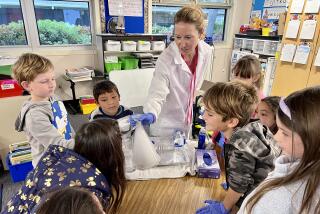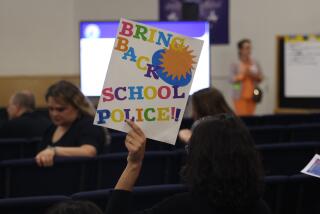School Labs Are Often Experiments in Danger
- Share via
GENOA, Ill. — In a flash, the routine high school chemistry experiment turned to chaos.
An alcohol-fueled fireball shot into the classroom, searing the skin of three junior honor students in the front row. They took the brunt of the blast on their faces, necks, arms, hands and legs.
The teacher pulled burning jeans off one of the girls; scorched skin fell from the boy’s face. The rest of the class scrambled for the door, leaving burned backpacks and books behind.
The fire at Genoa-Kingston High School last October may have been a horrible accident, but it was not unique. Across the country, at least 150 students have been seriously injured in school laboratory accidents in the last four years.
But the number is almost certainly much higher, according to interviews with researchers, school officials and insurance companies. And the stage is set for a significant increase, they said. As schools try to meet tough new science education standards set by the National Academy of Sciences in 1996, students are spending more time in laboratories. Some are crowded. Some have teachers with no safety training. Some are in 19th-century buildings ill-equipped for 21st-century science.
“Before, most kids were reading out of textbooks, but the new federal science standards absolutely, strongly, advocate hands-on, inquiry-based science,” said Kenneth Roy, who chairs an advisory board on science safety for the National Science Teachers Assn. “What this means is, you have to have safety concerns as job one, but some schools don’t.”
Teachers are protected in the workplace by state safety laws, but students are not. There is little regulation of school labs, and no government or private agency collects data on accidents that happen there. As a result, the exact number of accidents is unknown.
Almost all of the accidents and injuries could have been prevented with simple measures, experts said. But many teachers are unaware of the dangers, and there is no formal system to share information on accidents so that teachers can learn from others’ mistakes.
But they occur often enough to be considered a serious problem, according to safety experts and insurers who have paid millions of dollars to settle claims.
“There have been some terrible accidents and injuries that are just absolutely gross,” said John Wilson, executive director of the Schools Excess Liability Fund in California, which recently paid more than $1 million in one case involving a chemistry accident and more than $3 million in another.
A settlement is pending in a third case involving a Riverside girl who was burned over 20% of her body. She is getting treatment to reduce scarring and improve the use of her burned arm.
There is evidence that the number of accidents has risen since schools began adopting the new teaching standards. In Iowa, there were 674 accidents in the three school years from fall 1990 through the spring 1993, but more than 1,000 in the next three years, said Jack Gerlovich, who teaches science safety at Drake University.
The increase came after Iowa schools began adopting an early version of the new standards, he said. The number of lawsuits soared too, from 96 to 245. Gerlovich said he suspects the same thing is happening in other states.
If accurate statistics were gathered, he said, “I think the actual numbers would be much, much higher. But it’s the kind of problem nobody wants to face.”
*
When the swoosh of fire hit Autum Burton, she was returning to her seat in her chemistry class after taking a closer look at the colors of the flames in the six petri dishes on the teacher’s table.
In an instant, she was engulfed. “I could feel it eating at me and I could smell my skin burning,” she recalled. “I was on the floor trying to get this off with my hands.”
By the time someone finally managed to wrap her in a blanket and put out the fire, she was burned over almost half her body: face, neck, chest, arms and legs.
Burton, 19, now attends Columbia College in Chicago. Despite eight skin-graft operations and three laser treatments to diminish scarring on her face, she will be disfigured for the rest of her life.
The accident happened two years ago at Lakeview High School in Battle Creek, Mich. Just two months earlier, a 16-year-old girl was severely burned in a similar accident about 40 miles away, at Waverly High School near Lansing. In both cases, the experiments involved methyl alcohol.
A volatile chemical that ignites easily, methyl alcohol often is involved in the most catastrophic accidents. In recent years, it also has caused flash fires at schools in Santa Clarita and Riverside, Calif.; here in Genoa; Midland, Texas; New Berlin, Wis., and Washington, D.C.
If the teacher does not use an exhaust system, leaves the cap off the alcohol jug or pours too much into the dishes, fumes can build up and, if exposed to flame, create a flash fire. If the fumes come from an open bottle, the blast can eject the liquid, followed by a fireball.
“You get a flame-thrower effect,” said Steve Weston, a lawyer representing Burton and the student from Lansing. “It jettisons fluid from the bottle, whose opening is pointed like a gun right at these students.”
The fire marshal in Battle Creek determined Burton’s accident could have been prevented if an exhaust system in the room had been used to draw away fumes. And the injuries might have been minimized if the teacher had used a plastic shield or required the students to wear goggles.
In many cases, school officials believed such protection was unnecessary when students were watching, rather than participating in, an experiment, even though most state laws require eye protection under such circumstances.
But Gerlovich, the Drake University researcher, has found that more than 70% of North Carolina science teachers had never received safety training. He said surveys in 17 other states found an average of 55% to 65% of teachers have never been trained in safety.
Alan Paradise, assistant principal of East Bakersfield High School in California, said he never imagined students were in danger in the lab--until a glass bottle of methanol exploded three years ago, sending a teacher and 22 students to a hospital with cuts, headaches and nausea. The district began requiring shields and goggles and sent teachers for training.
The lack of training is alarming for another reason, experts said: Many teachers don’t know how to safely store chemicals, which can cause dangerous reactions if they accidentally mix. Some teachers store chemicals alphabetically instead of by chemical type, or keep them beyond their safe life span.
In Rogersville, Tenn., last March, old, unlabeled bottles of chemicals being removed from a school accidentally leaked and mixed, causing an explosion and fire. No one was hurt.
In Valley, Neb., officials cleaning out a school lab last year found a canister of picric acid, which crystallizes and becomes highly explosive with age. When they realized it could be 30 years old, they called the bomb squad.
Eight months after the Genoa-Kingston flash fire, Rachel Anderson, Eric Baenziger and Kara Butts are still recovering from their burns. Kara and Eric wear pressure garments 24 hours a day to reduce scarring and both will require skin grafts, said their lawyer, Michael Alesia. The students declined to be interviewed for this story.
All eventually returned to school. Administrators are trying to sort out what happened and whether they should change their chemistry procedures. The teacher was not disciplined and remains on staff, according to the school’s superintendent, Richard Leahy. The teacher did not respond to a request for an interview, but Leahy said, “No one agonized more than this man over hurting his students. He’s a retired professional chemist; he teaches because he loves it.”
The Genoa-Kingston case illustrates a lack of school safety oversight--a lack that is common in most states. Laws, if they exist, are almost never enforced in schools. Aside from eye-protection requirements, few laws are aimed specifically at students. School labs rarely undergo inspections from state or federal authorities and there usually are no requirements that accidents be reported to anyone outside the school.
“The schools are pretty much left on their own,” said James A. Kaufman, director of the Massachusetts-based Laboratory Safety Institute, a nonprofit agency that promotes school lab safety. “They all assume these are smart people, they have a science degree, they know how to do this properly.”
Federal Occupational Safety and Health Administration rules do not cover local or state employees, and in most states similar workplace safety laws apply only to employees. There is no OSHA equivalent to protect students; instead, it is assumed that if laws protect teachers, students also will be safe, experts said.
The Illinois Labor Department, for example, investigates school accidents only if someone reports them, said Al Juskenas, the department’s manager of safety inspection and education. But schools are only required to report accidents if someone is killed, or if three or more employees--not students--are injured seriously enough to go to the hospital. The department investigated the Genoa-Kingston case because a teacher complained, Juskenas said.
“I think lawmakers need to take another look at things,” said Roy of the National Science Teachers Assn. “But there is a lot on the books now that needs to be enforced, and teachers need training. You send your kids to school because you think they’re safe. It burns me that [accidents] are happening when they’re preventable.”
More to Read
Sign up for Essential California
The most important California stories and recommendations in your inbox every morning.
You may occasionally receive promotional content from the Los Angeles Times.










